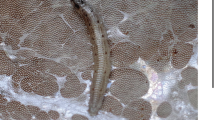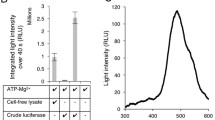Abstract
By determining the components involved in the bioluminescence process in luminous and nonluminous organs of the honey fungus Armillaria mellea, we have established causes of partial luminescence of this fungus. The complete set of enzymes and substrates required for bioluminescence is formed only in the mycelium and only under the conditions of free oxygen access. Since the synthesis of luciferin precursor (hispidin) and 3-hydroxyhispidin hydroxylase in the fruiting bodies is blocked, the formation of luciferin—the key component of fungal bioluminescent system—was not observed. That is why the fruiting body of Armillaria mellea is nonluminous despite the presence of luciferase, the enzyme that catalyzes the oxidation of luciferin with a photon emission.
Similar content being viewed by others
References
Airth, R.L. and Foerster, G.E., The isolation of catalytic components required for cell-free fungal bioluminescence, Arch. Biochem. Biophys., 1962, vol. 97, no. 3, pp. 567–573.
Shimomura, O., Bioluminescence: Chemical Principles and Methods, Singapore World Scientific Publishing Co. Pte. Ltd., 2006.
Purtov, K.V., Petushkov, V.N., Baranov, M.S., Mineev, K.S., Rodionova, N.S., Kaskova, Z.M., Tsarkova, A.S., Petunin, A.I., Bondar, V.S., Rodicheva, E.K., Medvedeva, S.E., Oba, Y., Oba, Y., Arseniev, A.S., Lukyanov, S., Gitelson, J.I., and Yampolsky, I.V., Angew. Chem., Int. Ed. Engl., 2015, vol. 54, no. 28, pp. 8124–8128.
Audrey, L.C.C., Desjardin, D.E., Tan, Y.-S., Musa, Md.Y., and Sabaratnam, V., Fungal Diversity, 2015, vol. 70, no. 1, pp. 149–187.
https://en.wikipedia.org/wiki/List_of_bioluminescent_-fungi
Moore, D., Robson, G.D., and Trinci, A.P.F., 21st Century Guidebook to Fungi, Cambridge: UK. Cambridge University Press, 2011.
Desjardin, D.E., Oliveira, A.G., and Stevani, C.V., Photochem. Photobiol. Sci., 2008, vol. 7, no. 2, pp. 170–182.
Wassink, E.C., in Bioluminescence in Action, London, UK: Academic Press, 1978, pp. 171–195.
Author information
Authors and Affiliations
Corresponding author
Additional information
Original Russian Text © K.V. Purtov, V.N. Petushkov, N.S. Rodionova, J.I. Gitelson, 2017, published in Doklady Akademii Nauk, 2017, Vol. 474, No. 4, pp. 510–512.
Rights and permissions
About this article
Cite this article
Purtov, K.V., Petushkov, V.N., Rodionova, N.S. et al. Why does the bioluminescent fungus Armillaria mellea have luminous mycelium but nonluminous fruiting body?. Dokl Biochem Biophys 474, 217–219 (2017). https://doi.org/10.1134/S1607672917030176
Received:
Published:
Issue Date:
DOI: https://doi.org/10.1134/S1607672917030176




